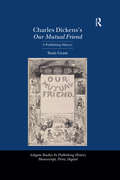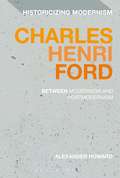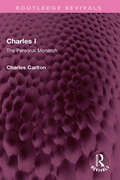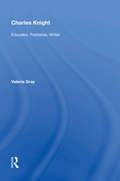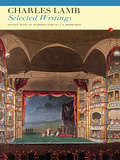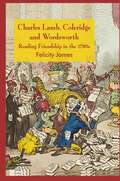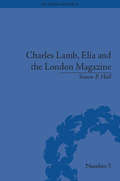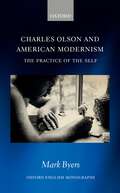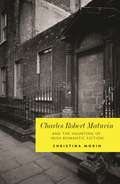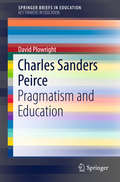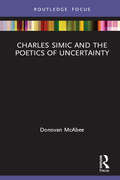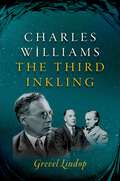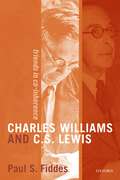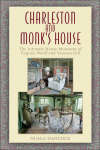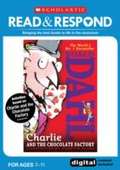- Table View
- List View
Charles Dickens's Our Mutual Friend: A Publishing History (Studies in Publishing History: Manuscript, Print, Digital)
by Sean GrassEven within the context of Charles Dickens's history as a publishing innovator, Our Mutual Friend is notable for what it reveals about Dickens as an author and about Victorian publishing. Marking Dickens's return to the monthly number format after nearly a decade of writing fiction designed for weekly publication in All the Year Round, Our Mutual Friend emerged against the backdrop of his failing health, troubled relationship with Ellen Ternan, and declining reputation among contemporary critics. In his subtly argued publishing history, Sean Grass shows how these difficulties combined to make Our Mutual Friend an extraordinarily odd novel, no less in its contents and unusually heavy revisions than in its marketing by Chapman and Hall, its transformation from a serial into British and U.S. book editions, its contemporary reception by readers and reviewers, and its delightfully uneven reputation among critics in the 150 years since Dickens’s death. Enhanced by four appendices that offer contemporary accounts of the Staplehurst railway accident, information on archival materials, transcripts of all of the contemporary reviews, and a select bibliography of editions, Grass’s book shows why this last of Dickens’s finished novels continues to intrigue its readers and critics.
Charles Dickens's Our Mutual Friend: A Publishing History (Studies in Publishing History: Manuscript, Print, Digital)
by Sean GrassEven within the context of Charles Dickens's history as a publishing innovator, Our Mutual Friend is notable for what it reveals about Dickens as an author and about Victorian publishing. Marking Dickens's return to the monthly number format after nearly a decade of writing fiction designed for weekly publication in All the Year Round, Our Mutual Friend emerged against the backdrop of his failing health, troubled relationship with Ellen Ternan, and declining reputation among contemporary critics. In his subtly argued publishing history, Sean Grass shows how these difficulties combined to make Our Mutual Friend an extraordinarily odd novel, no less in its contents and unusually heavy revisions than in its marketing by Chapman and Hall, its transformation from a serial into British and U.S. book editions, its contemporary reception by readers and reviewers, and its delightfully uneven reputation among critics in the 150 years since Dickens’s death. Enhanced by four appendices that offer contemporary accounts of the Staplehurst railway accident, information on archival materials, transcripts of all of the contemporary reviews, and a select bibliography of editions, Grass’s book shows why this last of Dickens’s finished novels continues to intrigue its readers and critics.
Charles Henri Ford: Between Modernism and Postmodernism (Historicizing Modernism)
by Alexander HowardThe first American surrealist poet, a prolific literary editor and a seminal influence on the New York School of poetry, Charles Henri Ford was a key figure in the transition from late modernist to postmodern culture in America. Charles Henri Ford: Between Modernism and Postmodernism is the first book-length scholarly study of this important literary figure. Drawing on new archival research – including explorations of Ford's correspondence with the likes of Ezra Pound, Gertrude Stein, William Carlos Williams, Parker Tyler, and many others – the book explores the full impact of Ford's contribution to 20th-century American literary culture.
Charles Henri Ford: Between Modernism and Postmodernism (Historicizing Modernism)
by Dr Alexander HowardThe first American surrealist poet, a prolific literary editor and a seminal influence on the New York School of poetry, Charles Henri Ford was a key figure in the transition from late modernist to postmodern culture in America. Charles Henri Ford: Between Modernism and Postmodernism is the first book-length scholarly study of this important literary figure. Drawing on new archival research – including explorations of Ford's correspondence with the likes of Ezra Pound, Gertrude Stein, William Carlos Williams, Parker Tyler, and many others – the book explores the full impact of Ford's contribution to 20th-century American literary culture.
Charles I: The Personal Monarch (Routledge Revivals)
by Charles CarltonFirst published in 1995, Charles I is a psychological portrait of the ‘monarch of the Civil Wars,’ Charles I. Challenging conventional interpretations of the king, as well as questioning orthodox historical assumptions concerning the origins and development of the Civil Wars, the book establishes itself as a definitive biography. Addressing and analysing the furious historiographical debates which have surrounded the period, Carlton offers a fresh and lucid perspective. This book will be of interest to students of literature and history.
Charles I: The Personal Monarch (Routledge Revivals)
by Charles CarltonFirst published in 1995, Charles I is a psychological portrait of the ‘monarch of the Civil Wars,’ Charles I. Challenging conventional interpretations of the king, as well as questioning orthodox historical assumptions concerning the origins and development of the Civil Wars, the book establishes itself as a definitive biography. Addressing and analysing the furious historiographical debates which have surrounded the period, Carlton offers a fresh and lucid perspective. This book will be of interest to students of literature and history.
Charles Knight: Educator, Publisher, Writer
by Valerie GrayCharles Knight: Educator, Publisher, Writer is the first modern book-length study of this important nineteenth-century educational reformer, author, and publisher. Though he made significant contributions during his lifetime to the cause of popular education, providing inexpensive but quality reading material for the newly literate working classes, Knight has been largely ignored by scholars. This neglect, the author suggests, may be related to Knight's association with the controversial Society for the Diffusion of Useful Knowledge and to the use scholars make of Knight's Penny Magazine and his two volumes on political economy to support their arguments on theories of social control and other issues. The author argues that Knight's reputation has suffered as a result. She reexamines the evidence to offer fresh assessments of Knight's life and work that illuminate his genuine achievements. She concludes with an evaluation of Knight's role as an innovative publisher who used the latest techniques to provide the emerging mass readership with unique combinations of text and image in his many 'pictorial' books and periodicals.
Charles Knight: Educator, Publisher, Writer (The\nineteenth Century Ser.)
by Valerie GrayCharles Knight: Educator, Publisher, Writer is the first modern book-length study of this important nineteenth-century educational reformer, author, and publisher. Though he made significant contributions during his lifetime to the cause of popular education, providing inexpensive but quality reading material for the newly literate working classes, Knight has been largely ignored by scholars. This neglect, the author suggests, may be related to Knight's association with the controversial Society for the Diffusion of Useful Knowledge and to the use scholars make of Knight's Penny Magazine and his two volumes on political economy to support their arguments on theories of social control and other issues. The author argues that Knight's reputation has suffered as a result. She reexamines the evidence to offer fresh assessments of Knight's life and work that illuminate his genuine achievements. She concludes with an evaluation of Knight's role as an innovative publisher who used the latest techniques to provide the emerging mass readership with unique combinations of text and image in his many 'pictorial' books and periodicals.
Charles Lamb: Selected Writings
by Charles LambCharles Lamb (1775-1834), essayist, poet, humorist, critic and letter-writer, has an enduring reputation for his early "Tales from Shakespeare" (1807), written in collaboration with his sister Mary, and his " Essays of Elia," first published in the "London Magazine." This thematic selection of Lamb's writings - essays, dramatic criticism, verse and
Charles Lamb: Selected Writings (Fyfield Bks.)
by Charles LambCharles Lamb (1775-1834), essayist, poet, humorist, critic and letter-writer, has an enduring reputation for his early "Tales from Shakespeare" (1807), written in collaboration with his sister Mary, and his " Essays of Elia," first published in the "London Magazine." This thematic selection of Lamb's writings - essays, dramatic criticism, verse and
Charles Lamb, Coleridge and Wordsworth: Reading Friendship in the 1790s
by Felicity JamesThis book makes the case for a re-placing of Lamb as reader, writer and friend in the midst of the lively political and literary scene of the 1790s. Reading his little-known early works alongside others by the likes of Coleridge and Wordsworth, it allows a revealing insight into the creative dynamics of early Romanticism.
Charles Lamb, Elia and the London Magazine: Metropolitan Muse (The History of the Book)
by Simon P HullThe inherent 'metropolitanism' of writing for a Romantic-era periodical is here explored through the Elia articles that Charles Lamb wrote for the London Magazine.
Charles Lamb, Elia and the London Magazine: Metropolitan Muse (The History of the Book #5)
by Simon P HullThe inherent 'metropolitanism' of writing for a Romantic-era periodical is here explored through the Elia articles that Charles Lamb wrote for the London Magazine.
Charles Olson and American Modernism: The Practice of the Self (Oxford English Monographs)
by Mark ByersThis volume situates the work of American poet Charles Olson (1910-1970) at the centre of the early post-war American avant-garde. It shows Olson to have been one of the major advocates and theorists of American modernism in the late 1940s and early 1950s; a poet who responded fully and variously to the political, ethical, and aesthetic urgencies driving innovation across contemporary American art. Reading Olson's work alongside that of contemporaries associated with the New York Schools of painting and music (as well as the exiled Frankfurt School), the book draws on Olson's published and unpublished writings to establish an original account of early post-war American modernism. The development of Olson's work is seen to illustrate two primary drivers of formal innovation in the period: the evolution of a new model of political action pivoting around the radical individual and, relatedly, a powerful new critique of instrumental reason and the Enlightenment tradition. Drawing on extensive archival research and featuring readings of a wide range of artists including, prominently, Barnett Newman, Mark Rothko, David Smith, Wolfgang Paalen, and John Cage, Charles Olson and American Modernism offers a new reading of a major American poet and an original account of the emergence of post-war American modernism.
Charles Olson and American Modernism: The Practice of the Self (Oxford English Monographs)
by Mark ByersThis volume situates the work of American poet Charles Olson (1910-1970) at the centre of the early post-war American avant-garde. It shows Olson to have been one of the major advocates and theorists of American modernism in the late 1940s and early 1950s; a poet who responded fully and variously to the political, ethical, and aesthetic urgencies driving innovation across contemporary American art. Reading Olson's work alongside that of contemporaries associated with the New York Schools of painting and music (as well as the exiled Frankfurt School), the book draws on Olson's published and unpublished writings to establish an original account of early post-war American modernism. The development of Olson's work is seen to illustrate two primary drivers of formal innovation in the period: the evolution of a new model of political action pivoting around the radical individual and, relatedly, a powerful new critique of instrumental reason and the Enlightenment tradition. Drawing on extensive archival research and featuring readings of a wide range of artists including, prominently, Barnett Newman, Mark Rothko, David Smith, Wolfgang Paalen, and John Cage, Charles Olson and American Modernism offers a new reading of a major American poet and an original account of the emergence of post-war American modernism.
Charles Robert Maturin and the haunting of Irish romantic Fiction
by Christina MorinA clear, theoretically-grounded, chronological study of Maturin’s six novels. A new critical paradigm by which to view and read Irish Romantic fiction. Offers the most comprehensive and up-to-date analysis of Maturin and his fiction available today.
Charles Sanders Peirce: Pragmatism and Education (SpringerBriefs in Education)
by David PlowrightThis book introduces a number of selected ideas from the work of Charles Sanders Peirce, the founder of pragmatism. Peirce, pronounced ‘purse’, was born in America in 1839 and died in 1914. He published little in his own lifetime and he continually struggled to become recognised as a respected author with ideas that were highly creative, original and unique. The book begins with an examination of Peirce’s life history. This is followed by an explanation of pragmatism, which states that an understanding of a concept can only be fully grasped by knowing what its practical effects are. The author then explains a number of Peirce’s ideas that are based on his pragmatic maxim: · scientific inquiry as a method of investigation and its relevance to everyday thinking· inferential thinking based on abduction, deduction and induction and its use in educational research· semiotics, the study of signs and its relevance to the development of conceptual understanding· his profound and insightful ontological categories of Firstness, Secondness and Thirdness and their application to developing an understanding of the world around usThis introductory text is written in a clear and accessible style. Numerous examples are used throughout the book to illustrate Peirce’s complex and sophisticated ideas and to show how his thinking can be applied to education.
Charles Simic and the Poetics of Uncertainty
by Donovan McAbeeCharles Simic and the Poetics of Uncertainty provides the first full account of the poetics of the former US Poet Laureate, who is one of the most popular and critically acclaimed English-language poets writing today. The book argues for uncertainty as the center of Simic’s poetics and addresses the ways that his poetry grows from and navigates various forms of uncertainty. Donovan McAbee addresses uncertainty regarding the national character of Simic’s poetry and how this is complicated by Simic’s identity as a Yugoslavian refugee to the United States. The book assesses the theological and linguistic uncertainties of Simic’s poetry and explores the ways that Simic articulates the aesthetic space created by poems, as a safe place of encounter for the reader. The book argues for the role of humor as a primary mode that holds together the uncertainties of Simic’s poetry, and finally, it articulates the way that within these uncertainties, Simic develops a deeply humane political poetry of survival. Along the way, Simic’s work is placed in conversation with key influences and other important American and international poets and writers, including James Tate, Mark Strand, Charles Wright, Nicanor Parra, Vasko Popa, and others.
Charles Simic and the Poetics of Uncertainty
by Donovan McAbeeCharles Simic and the Poetics of Uncertainty provides the first full account of the poetics of the former US Poet Laureate, who is one of the most popular and critically acclaimed English-language poets writing today. The book argues for uncertainty as the center of Simic’s poetics and addresses the ways that his poetry grows from and navigates various forms of uncertainty. Donovan McAbee addresses uncertainty regarding the national character of Simic’s poetry and how this is complicated by Simic’s identity as a Yugoslavian refugee to the United States. The book assesses the theological and linguistic uncertainties of Simic’s poetry and explores the ways that Simic articulates the aesthetic space created by poems, as a safe place of encounter for the reader. The book argues for the role of humor as a primary mode that holds together the uncertainties of Simic’s poetry, and finally, it articulates the way that within these uncertainties, Simic develops a deeply humane political poetry of survival. Along the way, Simic’s work is placed in conversation with key influences and other important American and international poets and writers, including James Tate, Mark Strand, Charles Wright, Nicanor Parra, Vasko Popa, and others.
Charles Williams: The Third Inkling
by Grevel LindopThis is the first full biography of Charles Williams (1886-1945), an extraordinary and controversial figure who was a central member of the Inklings—the group of Oxford writers that included C.S. Lewis and J.R.R. Tolkien. Charles Williams—novelist, poet, theologian, magician and guru—was the strangest, most multi-talented, and most controversial member of the group. He was a pioneering fantasy writer, who still has a cult following. C.S. Lewis thought his poems on King Arthur and the Holy Grail were among the best poetry of the twentieth century for 'the soaring and gorgeous novelty of their technique, and their profound wisdom'. But Williams was full of contradictions. An influential theologian, Williams was also deeply involved in the occult, experimenting extensively with magic, practising erotically-tinged rituals, and acquiring a following of devoted disciples. Membership of the Inklings, whom he joined at the outbreak of the Second World War, was only the final phase in a remarkable career. From a poor background in working-class London, Charles Williams rose to become an influential publisher, a successful dramatist, and an innovative literary critic. His friends and admirers included T.S. Eliot, W.H. Auden, Dylan Thomas, and the young Philip Larkin. A charismatic personality, he held left-wing political views, and believed that the Christian churches had dangerously undervalued sexuality. To redress the balance, he developed a 'Romantic Theology', aiming at an approach to God through sexual love. He became the most admired lecturer in wartime Oxford, influencing a generation of young writers before dying suddenly at the height of his powers. This biography draws on a wealth of documents, letters and private papers, many never before opened to researchers, and on more than twenty interviews with people who knew Williams. It vividly recreates the bizarre and dramatic life of this strange, uneasy genius, of whom Eliot wrote, 'For him there was no frontier between the material and the spiritual world.'
Charles Williams: The Third Inkling
by Grevel LindopThis is the first full biography of Charles Williams (1886-1945), an extraordinary and controversial figure who was a central member of the Inklings—the group of Oxford writers that included C.S. Lewis and J.R.R. Tolkien. Charles Williams—novelist, poet, theologian, magician and guru—was the strangest, most multi-talented, and most controversial member of the group. He was a pioneering fantasy writer, who still has a cult following. C.S. Lewis thought his poems on King Arthur and the Holy Grail were among the best poetry of the twentieth century for 'the soaring and gorgeous novelty of their technique, and their profound wisdom'. But Williams was full of contradictions. An influential theologian, Williams was also deeply involved in the occult, experimenting extensively with magic, practising erotically-tinged rituals, and acquiring a following of devoted disciples. Membership of the Inklings, whom he joined at the outbreak of the Second World War, was only the final phase in a remarkable career. From a poor background in working-class London, Charles Williams rose to become an influential publisher, a successful dramatist, and an innovative literary critic. His friends and admirers included T.S. Eliot, W.H. Auden, Dylan Thomas, and the young Philip Larkin. A charismatic personality, he held left-wing political views, and believed that the Christian churches had dangerously undervalued sexuality. To redress the balance, he developed a 'Romantic Theology', aiming at an approach to God through sexual love. He became the most admired lecturer in wartime Oxford, influencing a generation of young writers before dying suddenly at the height of his powers. This biography draws on a wealth of documents, letters and private papers, many never before opened to researchers, and on more than twenty interviews with people who knew Williams. It vividly recreates the bizarre and dramatic life of this strange, uneasy genius, of whom Eliot wrote, 'For him there was no frontier between the material and the spiritual world.'
Charles Williams and C. S. Lewis: Friends in Co-inherence
by Paul S. FiddesThis study of the literary relationship between Charles Williams and C. S. Lewis during the years 1936-1945 focuses on the theme of 'co-inherence' at the centre of their friendship. The idea of 'co-inherence' has long been recognized as an important contribution of Williams to theology, and had significant influence on the thought of Lewis. This account of the two writers' conviction that human persons 'inhere' or 'dwell' both in each other and in the triune God reveals many inter-relationships between their writings that would otherwise be missed. It also shows up profound differences between their world-views, and a gradual, though incomplete, convergence onto common ground. Exploring the idea of co-inherence throws light on the fictional worlds they created, as well as on their treatment (whether together or separately) of a wide range of theological and literary subjects: the Arthurian tradition, the poetry of William Blake and Thomas Traherne, the theology of Karl Barth, the nature of human and divine love, and the doctrine of the Trinity. This study draws for the first time on transcriptions of Williams' lectures from 1932 to 1939, tracing more clearly the development and use of the idea of co-inherence in his thought than has been possible before. Finally, an account of the use of the word 'co-inherence' in English-speaking theology suggests that the differences that existed between Lewis and Williams, especially on the place of analogy and participation in human experience of God, might be resolved by a theology of co-inherence in the Trinity.
Charles Williams and C. S. Lewis: Friends in Co-inherence
by Paul S. FiddesThis study of the literary relationship between Charles Williams and C. S. Lewis during the years 1936-1945 focuses on the theme of 'co-inherence' at the centre of their friendship. The idea of 'co-inherence' has long been recognized as an important contribution of Williams to theology, and had significant influence on the thought of Lewis. This account of the two writers' conviction that human persons 'inhere' or 'dwell' both in each other and in the triune God reveals many inter-relationships between their writings that would otherwise be missed. It also shows up profound differences between their world-views, and a gradual, though incomplete, convergence onto common ground. Exploring the idea of co-inherence throws light on the fictional worlds they created, as well as on their treatment (whether together or separately) of a wide range of theological and literary subjects: the Arthurian tradition, the poetry of William Blake and Thomas Traherne, the theology of Karl Barth, the nature of human and divine love, and the doctrine of the Trinity. This study draws for the first time on transcriptions of Williams' lectures from 1932 to 1939, tracing more clearly the development and use of the idea of co-inherence in his thought than has been possible before. Finally, an account of the use of the word 'co-inherence' in English-speaking theology suggests that the differences that existed between Lewis and Williams, especially on the place of analogy and participation in human experience of God, might be resolved by a theology of co-inherence in the Trinity.
Charleston and Monk's House: The Intimate House Museums of Virginia Woolf and Vanessa Bell
by Nuala HancockThis compelling new study reveals, for the first time, through an emplaced investigation, the potential of Charleston and Monk's House to illuminate the shared histories of Virginia Woolf and Vanessa Bell.
Charlie And The Chocolate Factory (Read And Respond Ser. (PDF))
by Eileen Jones<i>Read & Respond</i> has been fully updated with new content. It provides teachers with a wealth of resources to teach <i>Charlie and the Chocolate Factory</i>. Notes and activities reflect the changes in the new Curriculum and include shared texts, guided reading notes, reading activities, speaking and listening activities, writing projects and assessment guidance. The CD-ROM contains interactive activities. Chocolate rivers and toffee trees... Magic is on the menu in Roald Dahl's tastiest book!
